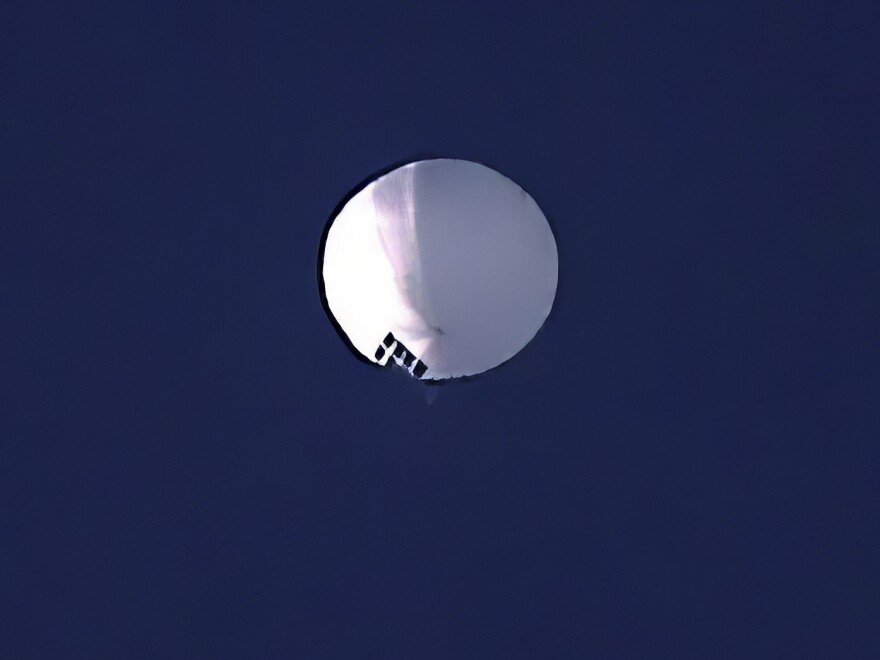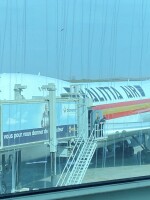Updated February 3, 2023 at 1:00 PM ET
The U.S. State Department says Secretary Antony Blinken has postponed his trip to Beijing amid concerns about a Chinese surveillance balloon flying over U.S. airspace.
The Pentagon said Thursday it had "very high confidence" that the high-altitude surveillance balloon came from China and is being used to collect information from sensitive sites.
China's foreign affairs ministry confirmed on Friday that the balloon is theirs, but called it a "civilian airship used for research, mainly meteorological purposes," that had gone off course by accident.
"Affected by the Westerlies and with limited self-steering capability, the airship deviated far from its planned course," it said in a statement. "The Chinese side regrets the unintended entry of the airship into US airspace due to force majeure. The Chinese side will continue communicating with the US side and properly handle this unexpected situation caused by force majeure."
Pentagon spokesperson Brig. Gen. Patrick Ryder pushed back on that assertion at a midday Friday press conference, saying U.S. officials know that the balloon is for surveillance purposes and has a payload attached for surveillance capability.
He added that the balloon is now over the center of the continental U.S. after tracking east from Montana, and reiterated that it poses no threat to people on the ground.
U.S. defense officials believe the balloon does not pose a "military or physical threat to people on the ground," as NORAD and U.S. Northern Command said in a Thursday statement, and recommended against shooting it down.
Mao Ning, China's foreign ministry spokesperson, previously told reporters that China has "no intention of violating the territory or airspace of any sovereign country" and urged people to remain calm and avoid speculation until all the facts are clear.
Still, some Republican lawmakers — including House Speaker Kevin McCarthy and Montana Rep. Ryan Zinke — are accusing China of provoking the U.S. and calling for the U.S. to address it.
The incident comes at a tense time for U.S.-China relations, with American national security concerns ranging from TikTok to Taiwan and just before Blinken was set to meet with Chinese President Xi Jinping in Beijing as part of an effort to diffuse those tensions.
The trip would have followed up on President Biden's meeting with Xi in Bali in November. Blinken was due to depart Friday, and would have been the first Biden administration Cabinet secretary to visit China.
The State Department says Blinken plans to reschedule the trip at the next soonest opportunity.
A senior State Department official speaking on background called the balloon incident "unacceptable and irresponsible," adding:
"We have noted the PRC statement of regret, but the presence of this balloon in our airspace is a clear violation of our sovereignty as well as international law, and it is unacceptable that this has occurred."
Here's what else we know so far.
What is a surveillance balloon?
These large balloons carry cameras or other equipment and float above a given area, usually at an altitude of about 80,000 to 120,000 feet, The Guardian reports. In contrast, commercial planes generally fly at about 35,000 feet.
Ryder, of the Pentagon, has said the balloon is "traveling at an altitude well above commercial air traffic."
The National Parks Service says the use of spy balloons within the U.S. dates back to the Civil War, when both sides used hot air balloons (usually tethered to the ground and reaching about 1,000 feet) to collect reconnaissance and direct artillery toward the other.
The practice became more widespread during World War I and then during the Cold War, when the U.S. launched hundreds of balloons to gather intelligence on China and the Soviet Union, Bloomberg reports.
Surveillance balloons have been overshadowed by satellites and unmanned drones in recent decades, though they still offer certain advantages (for instance, they're cheaper to launch and can conduct long-duration surveillance missions). Politico reported last year that the Pentagon was expanding investment in high-altitude balloon projects.
What do we know about this particular balloon?
This balloon is likely operating in the stratosphere, between 80,000 and 120,000 feet in altitude, according to James Flaten, a researcher at the University of Minnesota who works with NASA to teach students using high-altitude balloons.
Flaten says the balloon appears to be rigged for a long-duration mission.
"It clearly has solar panels," he says. "This is intended to stay up for a long time and power itself."
NASA uses similar balloons to launch experiments high above the Earth. They can inflate to as large as a quarter mile across, Flaten says, and carry payloads up to thousands of pounds.
Flaten says at these altitudes, objects tend to move horizontally around the world from West to East and stick to a fixed latitude, so it could be that the Chinese government launched this balloon from its own territory.
"It wouldn't be impossible at all for a balloon from China to overfly the United States," he says.
But at the same time, he says he doubts that the Chinese government would have much control over its exact path.
"The balloon will go with the wind; these are not horizontally-powered devices for the most part," he says.
And, Flaten adds, in the stratosphere, balloons can behave unpredictably. He thinks it is possible that this Chinese balloon, whatever it is, is not where it's supposed to be.
"I'm not saying they're telling the truth, I'm just saying that's a plausible story," he says.
What is it looking for?
U.S. officials said Thursday that the U.S. had been tracking the balloon since it entered U.S. airspace a few days ago. They didn't specify its exact timeline or path other than to confirm it floated over Montana at one point (the white circle is so large that people could spot it from the ground).
U.S. officials have broadly said it was flying over sensitive sites to collect information.
Montana is home to one of America's three nuclear missile silo fields at Malmstrom Air Force Base, which could be of interest, NPR national security correspondent Greg Myre told All Things Considered.
"The U.S. and China are always trying to gather intelligence on each other, but usually not in a way like this that is so obvious and almost certain to be detected," he added.
China's foreign ministry did not mention surveillance in its statement, simply describing the object as "a civilian airship used for research, mainly meteorological, purposes."

Why didn't the U.S. shoot it down?
A senior defense official told reporters Thursday that the U.S. had prepared fighter jets to shoot down the balloon if ordered, but that the Pentagon recommended against it, in part because of the risk that debris from such a large balloon could pose to people on the ground.
"It doesn't seem that this balloon is capable of gathering intelligence that would be significantly beyond what could also already be gathered by, say, satellites," Myre added.
But, he said, the U.S. is using some of those fighter jets to "take a peek" at the balloon in its efforts to keep monitoring it.
Flaten, the balloon researcher, agrees it might make sense to leave it be:
"If you had a hundred or 200 pounds of stuff and that came tumbling down from a high altitude, that wouldn't be very good for whatever it landed on."
What's the argument for shooting it down?
"We shouldn't let this thing be floating above our ICBM fields, or really over the U.S. in general," says Tom Karako, a senior fellow with the International Security Program who is also the director of the Missile Defense Project at the Center for Strategic and International Studies.
The balloon could be carrying a camera, Karako said, but it could also be trying to soak up signals intelligence and sensitive communications.
"It's hard for me to believe that if we were putting a balloon over China and they had the capacity to take it down, that they wouldn't do so," he said.
Shooting the balloon down or taking it down through other means could accomplish two things: It would immediately demonstrate the U.S. displeasure, and the payload could yield important information.
"If we recovered it in some capacity, we take it apart and perhaps learn something about [China's] own signals intelligence, or whatever the payload is," Karako said.
Karako dismissed China's characterization of the craft as a weather balloon. He also notes the Pentagon's assertion that the balloon's owner has "put it over the continental United States for an extended period of time."
What happened in Canada?
Canada also says it's monitoring a high-altitude surveillance balloon, though it's not clear if it's the same one. U.S. officials said the balloon they are tracking flew over the Aleutian Islands and through Canada before it was spotted Wednesday over Billings, Montana.
"Canadians are safe and Canada is taking steps to ensure the security of its airspace, including the monitoring of a potential second incident," the Canadian Department of National Defence said in a brief statement on Thursday.
It added that it is in frequent contact with the U.S. as the situation develops.
"Canada's intelligence agencies are working with American partners and continue to take all necessary measures to safeguard Canada's sensitive information from foreign intelligence threats," it said.

Have we seen this kind of thing before?
The Pentagon said similar balloon activity has been seen on occasion in recent years.
A defense official "wouldn't characterize this as revolutionary," Myre reports, adding that what seems to be different this time around is the altitude of the balloon and the length of time that it's staying over the U.S.
The U.S. Naval Institute pointed to one not-so-recent memory in a Thursday evening tweet: During World War II, the crew of the USS New York spotted a sphere in the sky that they suspected was a Japanese balloon. After multiple unsuccessful attempts at shooting it down, they realized they were actually shooting at Venus.
What was Blinken planning to do in China?
Tensions were already high this week, when the U.S. announced it would expand its presence in Southeast Asia with access to more bases in the Philippines — a move China said would threaten security in the region.
The balloon situation creates more friction between the countries and has given China hawks in the U.S. more material to seize on, as NPR's Beijing correspondent Emily Feng tells Morning Edition.
"The U.S. and China have been trying to stabilize their relationship, but this incident and ongoing bipartisan efforts to increase sanctions on China get in the U.S. officials and former diplomats tell Feng it might result in a joint statement, perhaps about combating climate change or against the use of nuclear weapons in Ukraine, but no major breakthroughs are likely.
Still, they had said the fact that Blinken was visiting China at all was a sign of progress.
"There are some meaty issues at the heart of their relationship over human rights, combating climate change, technological competition," Feng says. "So that involves getting China on board, even if the two countries don't see eye to eye."
Correspondents Michele Kelemen and Greg Myre contributed to this report. Correspondent Emily Feng contributed from Taipei, Taiwan.
Copyright 2023 NPR. To see more, visit https://www.npr.org.







